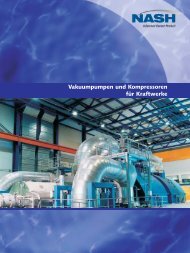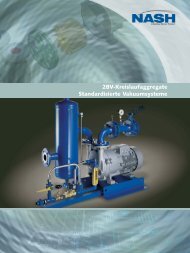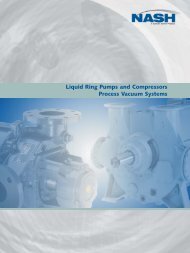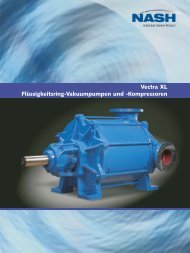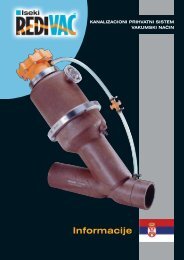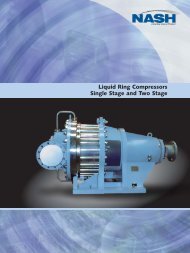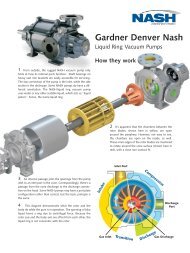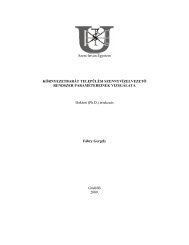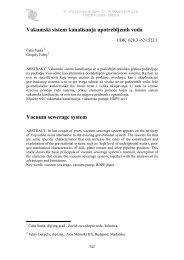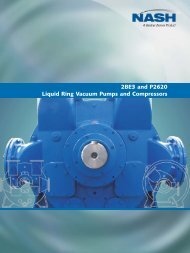introduction
introduction
introduction
You also want an ePaper? Increase the reach of your titles
YUMPU automatically turns print PDFs into web optimized ePapers that Google loves.
If the water cooling unit was to fail on a system fitted with liquid ring vacuum pumps it would not<br />
cause a system failure as the vacuum pumps would continue to run safely. There would be a fall<br />
in the efficiency of the pumps as the service water temperature rose, causing the pumps to run<br />
for a somewhat longer time than in normal operation.<br />
The station telemetry will raise the alarm within minutes of a problem occurring.<br />
Following reinstatement after a failure, the system will recover to normal operation entirely<br />
automatically.<br />
3. Are blockages encountered in vacuum sewers?<br />
This is an extremely rare occurrence. The sewage is moved through the vacuum sewers at high<br />
velocities; up to 6 metres per second in the form of a foamed ‘plug’. This makes the pipework<br />
self-cleaning. This, coupled with the fact that the system’s vigorous action breaks up solids,<br />
means that blockages almost never occur.<br />
4. Is the vacuum main prone to damage and, if so, what procedures are to be followed to<br />
locate the fault?<br />
If the recommendation regarding the use of high density polyethylene pipe with electro-fusion<br />
fittings is followed, then the vacuum main is not prone to damage as this produces an extremely<br />
strong and resilient integrated line. The only way that this is likely to be damaged is by unlawful or<br />
careless excavation. In the event of this happening, the telemetry alarm will then be raised and<br />
the maintenance operative will quickly be able to isolate which line has been damaged. It will<br />
then be a simple matter to locate the position of the excavation that has damaged the pipe.<br />
Location of any damage can be achieved by use of Iseki RediVac’s monitoring system, by use of<br />
the marker/tracer tape or by simply looking to see if any holes have been dug in the vacuum<br />
sewer trench line.<br />
If an interface valve should fail in the open position and cause the system vacuum to fail, the<br />
individual valve telemetry will register this and the maintenance operative will instantly be able to<br />
locate the fault and rectify it.<br />
In the very unlikely event of a leak or blockage developing in a vacuum main from a cause other<br />
than excavation, then the method of locating the leak is as follows:<br />
• Firstly, each main is shut down in turn at the station so that the main on which the fault lies<br />
is quickly ascertained. Next, by shutting the isolating valves it can be established on which<br />
branch of the main the fault lies.<br />
• Then, using the Iseki valve monitoring system and a portable monitor, it is possible to<br />
determine between which two valves the fault has occurred. In practice, this distance is<br />
unlikely to be much more than about fifty metres. The benefit of using the valve telemetry<br />
system in this diagnostic mode is that the number of isolation valves on the system can be<br />
kept to a minimum.<br />
• The precise location of a blockage is discovered by removing the downstream valve and<br />
inserting flexible rods to identify the point of blockage. After identifying this point, a repair<br />
can be carried out as with a conventional sewerage system, but this is simpler on a vacuum<br />
system because the depth of the main is minimal and polyethylene pipe is very easily and<br />
quickly repaired using electro-fusion couplings.<br />
• Because the existence of a fault would be immediately brought to the attention of the<br />
maintenance authority via the telemetry , the fault could be quickly repaired and not remain<br />
undiscovered, leaking pollution into the surrounding soils as can happen with a<br />
conventional system.<br />
As part of the training offered by Iseki RediVac to the client’s maintenance operatives, the above<br />
procedures are fully described and demonstrated in detail.<br />
36



